Introduction: When the market's attention focuses on a long-silent cryptocurrency and witnesses its astonishing surge of over 10 times since the end of September, this is no mere coincidence of speculation. The meteoric rise of Zcash not only sounds the rallying cry for the narrative of "financial privacy rights" but also heralds the emergence of a brand new track.
I. The True Performance of Zcash's Surge: Frenzied Prices and Rising On-Chain Adoption Rates
This celebration led by Zcash is not just a price game; it is a powerful testament to the real user demand and growth in on-chain activity.
1. Price Performance: Reshaping Market Confidence
Zcash (ZEC) has staged a breathtaking "epic awakening" after years of silence. The price has skyrocketed from a long-term depressed low range, achieving an astonishing surge of over 10 times in just two months, reaching $560 at the time of this article's publication.
The core signal of this frenzy lies in ZEC's successful and decisive breakthrough of the bear market resistance line that lasted for four years (refer to the key turning points in the chart). This is not only a historic breakthrough on the technical front but also sends a clear message to the market— the sleeping giant of the privacy track has fully awakened, instantly igniting massive speculative buying and algorithmic trading, pushing ZEC into a new spotlight.
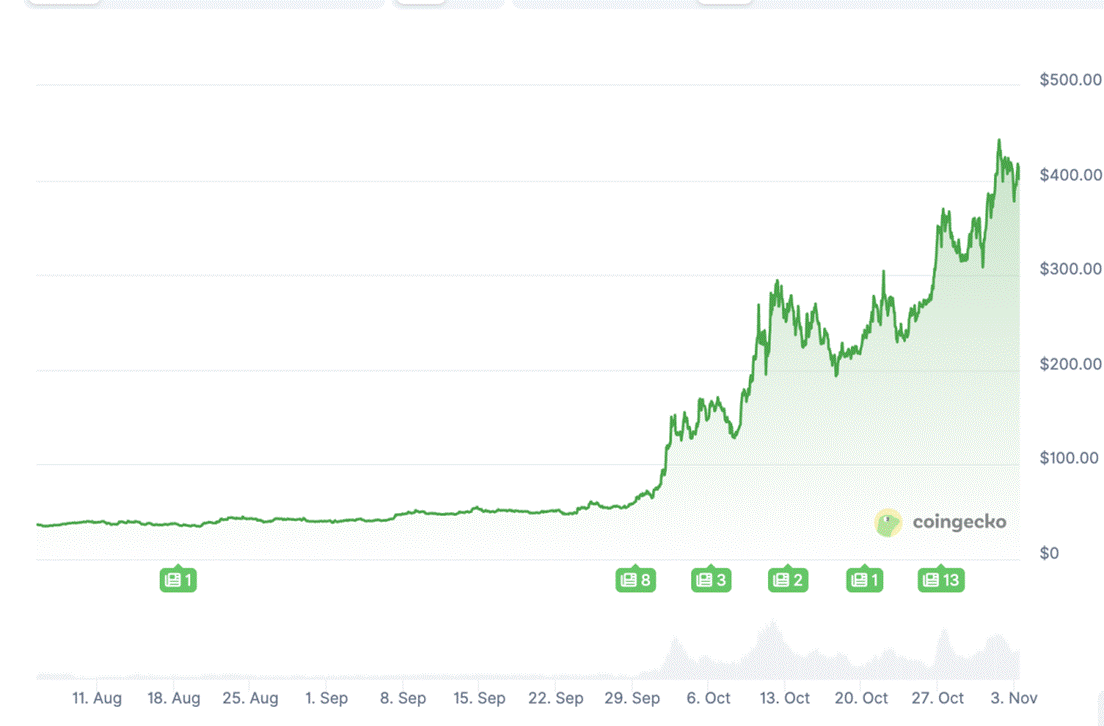
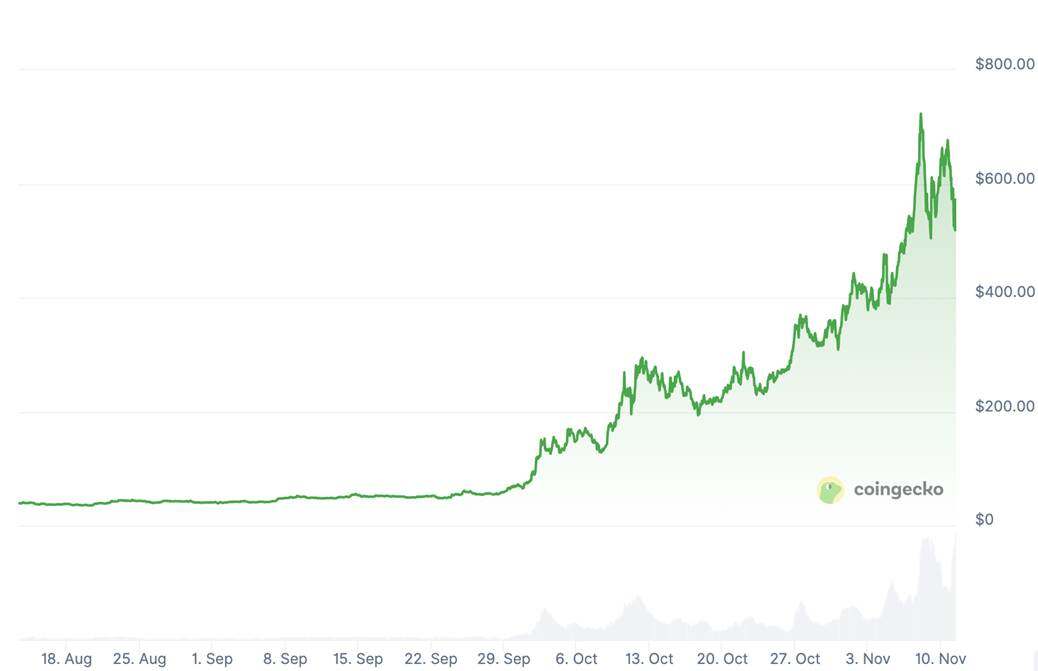
Coingecko: ZEC price chart showing an astonishing curve of over 10 times increase from a low position within two months
2. Golden Signals from On-Chain Data: Surge in Privacy Adoption Rates
Equally important to the price surge is the positive change in Zcash's on-chain data. These data are the most authentic proof of the "return of the privacy narrative":

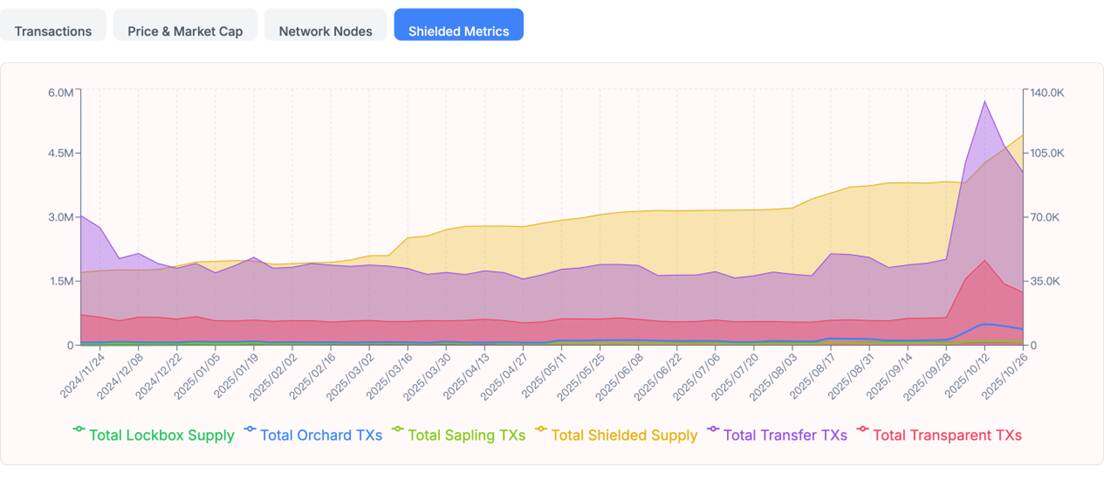

zechub: Zcash hidden pool data


zechub: Zcash hidden pool transaction data
II. Core Reasons for the Surge: Macroeconomic Trends, Technical Awakening, and Celebrity Ignition
Zcash's surge is the result of the interplay of fundamentals, macro trends, technical signals, and the influence of top KOLs. These factors together have built this market frenzy:
1. Macroeconomic Background and Scarcity Expectations: A Call of the Times and Approaching Halving
A. Rigid Demand Explosion Under Regulatory Pressure:
As global regulatory agencies tighten their monitoring of cryptocurrencies (such as KYC and on-chain tracking requirements), the "naked anxiety" of the digital financial world has been magnified. This demand for combating censorship and protecting personal financial sovereignty has reignited the market's strong, rigid demand for privacy-protecting assets. Zcash, as a leader in adopting zero-knowledge proof technology (zk-SNARKs), has become the focal point for capital inflow.
B. Scarcity Expectations from Halving: Reduction of Selling Pressure
Zcash is expected to undergo a block reward halving in November 2025. The halving will not only reduce the selling pressure from miners but also create strong scarcity expectations in the market, triggering behavior similar to that seen before Bitcoin's halving. Traders recognize this as a well-timed opportunity with ample liquidity and a clear narrative.
2. Resonance of Technology and Capital: Long-Term Accumulation and Grayscale's Layout
A. Awakening and Breakthrough of Underlying Technology:
The price of ZEC has successfully broken through the long-term descending resistance line that has persisted for four years, signaling a shift from long-term bearish to bullish. During the prolonged bear market, ZEC underwent years of consolidation and lows, completing a sufficient accumulation period for institutions and early investors. Once the price breaks through key technical resistance levels, it immediately triggers a large number of short-covering and algorithmic trading buy signals.
B. Institutional Interest Boost: Grayscale's Trust Effect
Grayscale Investments has decided to allow qualified investors to invest in the Grayscale Zcash Trust. This move has significantly increased institutional interest and speculative sentiment in the market. Grayscale's endorsement marks the formal entry of privacy assets into the sights of large funds, paving the way for subsequent massive capital inflows.
3. Top Opinion Leaders' "Prophecies": Arthur Hayes Ignites FOMO
Among all factors, the public bullish analysis by BitMEX co-founder Arthur Hayes is undoubtedly the core catalyst that ignited retail FOMO sentiment.
A. Impactful $10,000 Prediction
Hayes published a bullish analysis predicting that ZEC could reach $10,000 in the next privacy cycle, a very high target price that has drawn significant market attention. His core argument is: "The four-year cycle is dead, the liquidity cycle endures," positioning Zcash as "insurance against Bitcoin's transparency," fundamentally enhancing ZEC's investment value and narrative height. Recently, Hayes tweeted that "due to the rapid price increase, ZEC has become the second-largest liquidity holding in Maelstrom (his family office) investment portfolio, second only to Bitcoin."
B. Influence Review: Proof of the Hayes Effect
Arthur Hayes is widely regarded as one of the most influential opinion leaders in the crypto world. As a co-founder of BitMEX, he is known for his independent and macro market views, and his analytical articles and public statements are often cited by mainstream crypto media, indeed having a certain influence on short-term market sentiment.
1. Macroeconomic Narrative and Long-Term Belief: Million-Dollar Bitcoin Prediction
In May 2025, Hayes predicted in his personal blog and subsequent media interviews that Bitcoin could reach $1 million by 2028. This view was widely reported by media outlets such as CoinTelegraph, The Defiant, and Decrypt. He pointed out that the main driving force behind Bitcoin's price is global liquidity (especially USD liquidity) and central bank balance sheet expansion, rather than just the halving mechanism. This macro perspective adds strong logical consistency and foresight to his market analysis.
2. HYPE Token Prediction: From Statements to Market Reactions
In August 2025, Hayes publicly expressed his optimism for the decentralized derivatives protocol Hyperliquid's native token HYPE at the WebX 2025 conference, believing it could achieve up to 126 times growth in the next three years. This statement quickly sparked community discussions and was reported by media such as CoinMarketCap and Yahoo Finance. While it is difficult to quantify the short-term impact precisely, CoinMarketCap data shows that HYPE's price did see a slight increase within a week after Hayes's remarks, with some market observers attributing this to the FOMO sentiment brought about by the "Hayes Effect." In September 2025, according to CoinMarketCap, Hayes sold part of his HYPE holdings, realizing a profit of about 19.2%. Although this trade was a short-term operation, it was seen in the market as a typical case of his speculative cycle and liquidity management strategy, further reinforcing the market impression of the "Hayes Effect."

4. Top Talent and Technology's Endorsement: Amplifiers of Belief
Following Hayes's prophecy, more of the industry's most influential figures have come forward to further solidify market confidence:
• Naval Ravikant and other well-known investors have publicly expressed their support.
• Former Coinbase engineer and Helius CEO Mert Mumtaz has shown support. Mumtaz emphasized that the upcoming technological upgrades for Zcash will enhance performance by 1000 times, reigniting enthusiasm for its zk-SNARK-based privacy architecture.
III. Team's Response After the Surge
The development and support entities of Zcash (ECC and Zcash Foundation) have avoided direct comments on the price but emphasize their core technological advantages and the continuously growing fundamentals.
• Expansion of Core Development Force (Manhattan Project): Helius Labs CEO Mert Mumtaz is working to assemble a new independent core team for Zcash, focusing on scalability and security, aiming to create a "Manhattan Project" for privacy currencies. This move demonstrates to the market that top talent is deeply involved in the future development of Zcash.
• Promoting Adoption and Infrastructure: The team actively emphasizes Zcash's core technological advantages (such as zero-knowledge proofs zk-SNARKs) and further improves the Zashi wallet, with such product innovations aimed at providing superior and more convenient privacy and cross-chain experiences.
•Data Presentation and Transparency: The team and its supporters actively share on-chain data, particularly the growth of total Shielded ZEC and number of hidden transactions, to demonstrate that the price increase is supported by actual user adoption rates and improvements in fundamentals.
•Exploration of Compliance: ECC continues to address the compliance issues of privacy coins, such as through a Selective Disclosure mechanism that allows users to prove the source of their funds when necessary to meet institutional and regulatory demands, while still retaining core privacy.
IV. Impact of the Surge: Collective Explosion and Differentiation in the Privacy Track
The surge of Zcash (ZEC) has generated a significant chain reaction in the cryptocurrency market, successfully bringing the theme of "privacy" back into the spotlight, causing funds to flow from mainstream assets into this "forgotten sector," leading to a collective rise in the entire privacy coin sector, while also triggering profound industry reflection and comparison.
- Market Impact

- Comparison of Collective Explosion and Differentiation in the Privacy Coin Sector
The success of ZEC is almost a signal of a "privacy coin bull market," but the market performance and technical advantages of different tokens have shown significant differentiation:
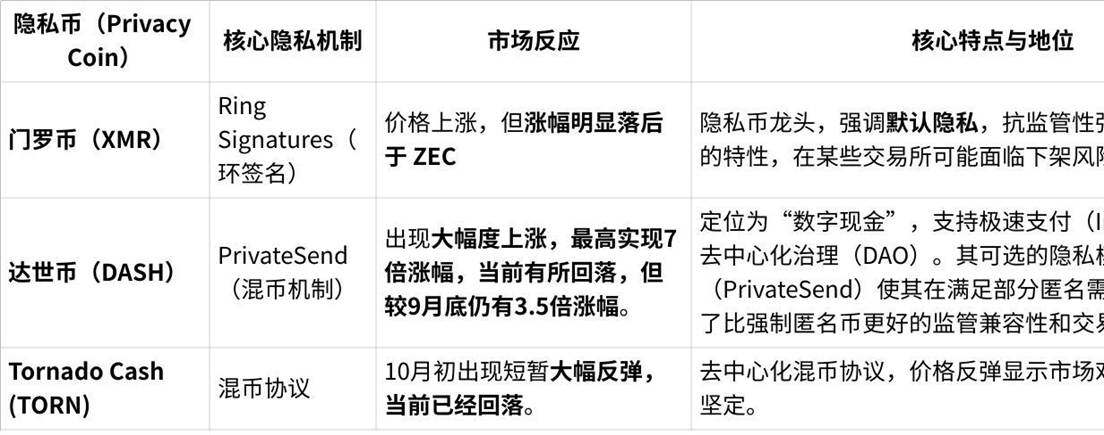
Zcash's high-profile performance and the collective celebration of the sector also bring a potential risk: it may prompt global regulatory agencies to accelerate the pace of legislation and regulation on privacy coins, posing a potential threat to privacy coins that rely on centralized infrastructure (such as exchanges).
V. From "Privacy Coins" to "Privacy Payment Solutions"
The recent phase of surging prices for privacy coins like Zcash is not an isolated speculative event but a signal that the issue of privacy is being refocused in the crypto industry. Although short-term price fluctuations are still influenced by market sentiment, KOL statements, and liquidity rotations, privacy protection is becoming one of the core demands of users—this is a "functional vote" cast with real money in the crypto market. However, the existing privacy coin systems (such as Zcash and Monero) still face three major structural limitations at the technical and ecological levels, which hinder the mainstream, large-scale, and seamless adoption of privacy technology.
1. Limitations of "Asset Islands"
In most privacy coin models, users must use the project's native tokens (ZEC, XMR) to achieve privacy transactions. This means that to gain privacy features, users must purchase and hold specific tokens, thereby incurring additional asset allocation costs and price volatility risks. This structure turns "privacy" into an accessory attribute of a certain currency rather than an optional service. Increasingly, research and industry trends show that users prefer to obtain privacy protection on existing assets (USDT, ETH, mainstream stablecoins) rather than being forced into a new coin ecosystem for privacy features.
2. Limitations of "User Experience"
The user experience of privacy coins and privacy protocols generally has a high threshold. Taking Zcash as an example, users need to distinguish between transparent addresses and shielded addresses (z, which, while private, causes wallet compatibility issues; Monero's transaction construction and signing process are relatively slow, leading to confirmation delays; and in on-chain privacy protocols (such as Railgun, Aztec), the computational load for generating zero-knowledge proofs remains high, and gas costs are still relatively expensive. In this regard, the Messari report "State of Privacy Tokens Q3 2025" points out: "Complex user experiences and high transaction costs are among the biggest obstacles to the mainstream adoption of privacy protocols." Ideally, privacy payments should not make users aware of technical complexities; sending a private transaction should be as simple, instant, and secure as sending a red envelope.
3. Limitations of "Ecological Compatibility"
Most privacy coins still operate on independent chains, disconnected from the rapidly expanding DeFi, GameFi, and Layer-2 ecosystems. Zcash and Monero currently lack native cross-chain interoperability, making it difficult for users to utilize privacy assets in mainstream multi-chain ecosystems. As the Messari report points out: "The independence of privacy coins is their security foundation, but also the biggest obstacle to adoption—they are inherently isolated from the mainstream economic layer." The future of privacy technology should clearly not come at the expense of usability and openness. A true privacy payment solution should become a foundational standard like HTTPS on the internet, rather than an isolated ecosystem.
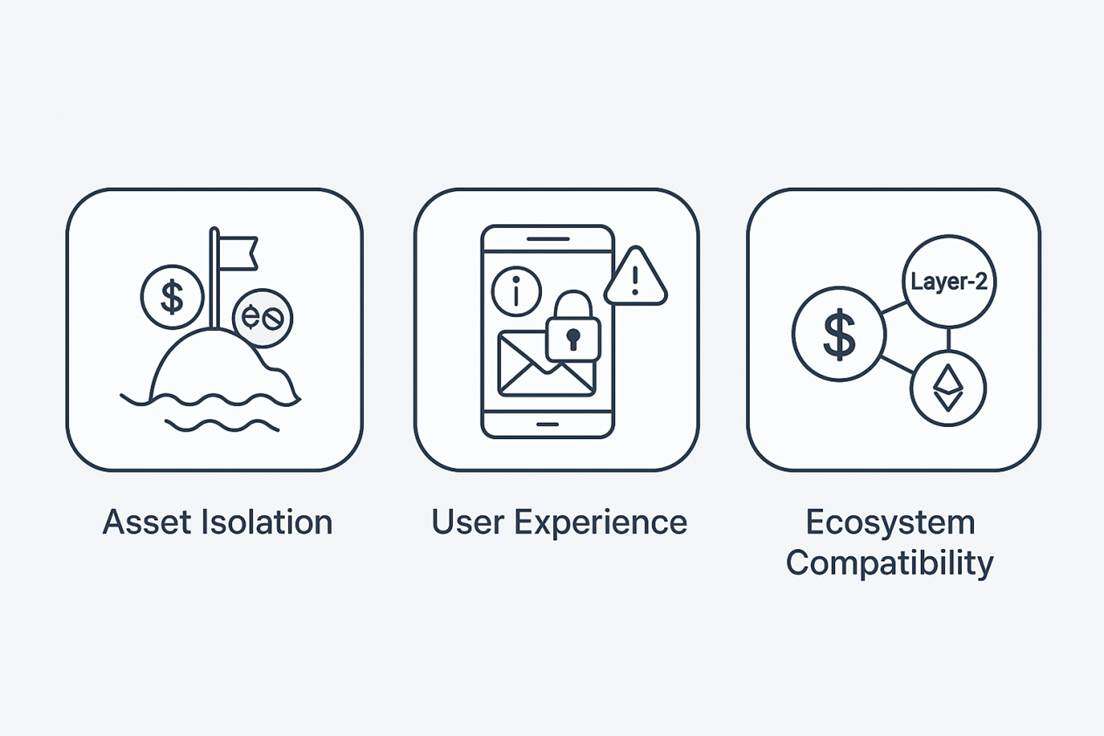
Paradigm Shift from "Privacy Coins" to "Privacy Payment Solutions"
What we need is not just a privacy coin, but a "privacy payment solution" or "universal privacy layer" that can thoroughly address the above pain points, which needs to achieve the following:
•From Assets to Functions: Privacy should no longer be tied to specific tokens but should be abstracted as a function or service that can be invoked by any digital asset.
•Ecological Composability: It should be able to seamlessly integrate with DeFi, GameFi, and other Web3 applications. Users can bridge privacy assets or interact with other protocols within the privacy layer while maintaining anonymity.
•User Experience Optimization: Transaction confirmations must reach an instant or near-instant level, with low fees, and the operational process should be simple and intuitive, allowing ordinary users to use it without barriers.

VI. New Opportunities in the Privacy Payment Track: Insights from Zcash's Surge on the Potential of Privacy Payment Public Chains
Zcash's surge has brought privacy coins and the privacy payment track back into the spotlight. With Zcash breaking through long-term lows and recording over a 10-fold increase in a short time, the market has re-evaluated the long-underestimated narrative of "privacy." For investors, such price performance is not just a market fluctuation but a strong market signal—privacy payment technology and privacy assets are entering a new cycle of attention.
Investor Perspective: From Price Signals to Track Judgments
For many market participants, Zcash's rapid rise has amplified sentiment: reversing from a low point to around $560 in two months, this level of movement is hard to simply view as a "technical rebound." In the context of tightening global regulations and highly visible on-chain behavior, privacy protection is beginning to evolve from an "optional" to a "necessary capability," prompting investors to reassess a question based on price signals:
Will privacy payments become one of the main lines of the next round of crypto technology and applications?
Traditional privacy coins have long oscillated between performance, usability, and regulatory pressure; the era of merely "being an anonymous coin" is clearly over. The market is more eager for an infrastructure that "protects privacy and can truly be used"—not just adding privacy components to existing public chains but deeply customizing for privacy payment scenarios from the ground up.
Awakening of the Privacy Payment Track: New Narratives After Zcash's Surge
After the price increase of Zcash, the attention on the privacy payment track has noticeably risen, and market discussions have gradually shifted from "anonymous speculation" to the perspective of "privacy rights and financial infrastructure." Whether in crypto asset trading, cross-border fund flows, or in the multi-chain usage of DeFi protocols, users are beginning to realize that completely transparent addresses and fund trails are bringing actual behavioral pressures and risk exposures.
In this context, the BenFen privacy payment solution, as a representative of the new generation of privacy public chain routes, is starting to be seen as a noteworthy sample in the industry.
Unlike traditional "plug-in privacy solutions," BenFen has written "privacy" into its system-level goals from the design starting point:
• Not just adding a layer of masking at the L2 or application layer,
• But customizing for privacy payments at the full-stack level from the underlying architecture to the application interface.
Its technical choices—security-first Move language, high-performance DAG consensus architecture, and stablecoin native integration capabilities—point in one direction: to provide a foundational base for the next generation of privacy payments that balances security, performance, and usability, weighing "whether it can be used," "how well it can be used," and "whether it is safe" on the same design table.
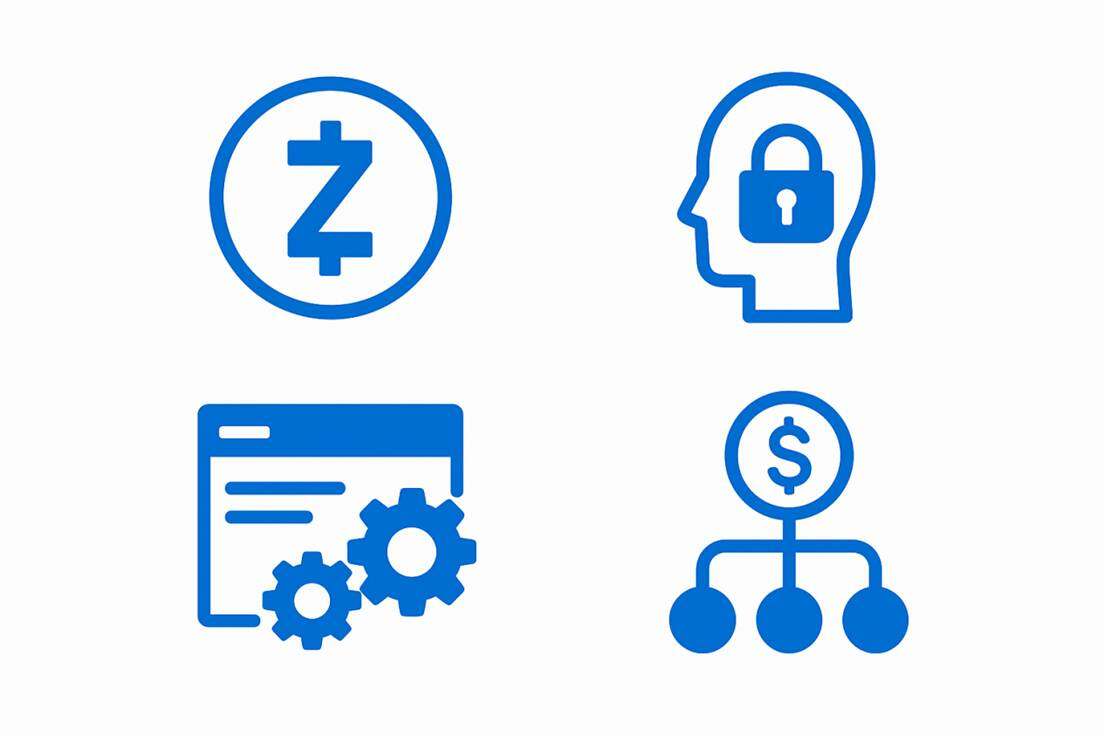
"Usable Privacy": Finding Balance Between Privacy and Verifiability
Unlike some traditional privacy coins that only emphasize "complete data masking," BenFen's technical path leans more towards "usable privacy": finding an engineering balance between privacy protection and verifiability.
In the underlying confidential transaction system, BenFen integrates multi-party secure computation (MPC) and key sharding technology, aiming to achieve "data available but invisible":
• Assets are transferred within the network,
• Nodes can complete consensus and state updates,
• But the core sensitive information of transactions is not exposed in plaintext on the public network.
At the same time, BenFen has designed a threshold decryption mechanism at the protocol layer, which allows selective disclosure of certain transaction details only under specific conditions and through multi-party collaboration. This design retains privacy while leaving room for "verifiable" technical interfaces for compliance audits, risk control checks, and other scenarios, creating space between privacy protection and trust infrastructure.
User Experience Aspect: Making Privacy the "Default Option"
From the user side, what BenFen attempts to do is lock complexity in the background and make privacy a "default capability":
• Privacy transactions should be as close as possible to ordinary transfers in terms of operation,
• Users should not need to learn additional processes or understand complex cryptographic terminology,
• Privacy protection should be automatically executed in the system background.
In terms of cost experience, through a sponsored transaction model, the project party can cover gas fees, thus achieving a near "zero gas" usage path in specific scenarios, bringing privacy payments down from a "high-threshold, expert-level function" to a daily capability that ordinary users can naturally use.
From "Anonymous Narrative" to "Practical Privacy": The Direction Represented by BenFen
Zcash's surge has caused the market to look back at the privacy track; the technical solution of BenFen, to some extent, reflects the evolution direction of this track's narrative—from a single "anonymous story" to a practical privacy infrastructure that balances performance, compliance interfaces, and everyday usability.
At the underlying level, BenFen attempts to find a balance among three things:
• Privacy Protection: Data is not exposed, and fund trails are not arbitrarily depicted;
• Performance Efficiency: It can still support high-frequency payments and complex asset flow needs;
• User Experience: As "unobtrusive" as possible for end users, lowering participation thresholds.
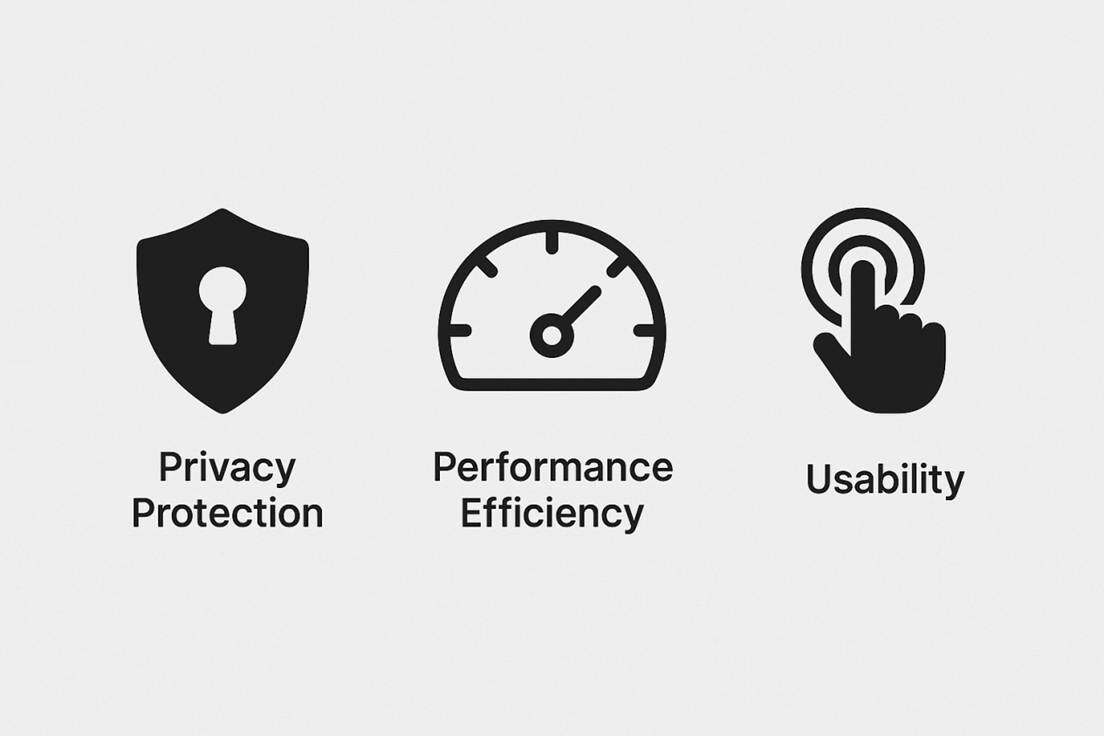
For individual users, this means that their daily on-chain payments, multi-chain asset management, and cross-border flows can have an additional option of "privacy enabled by default"; for institutional players and protocol developers, it provides an underlying framework that can be used to build privacy-friendly payment, settlement, and clearing systems.
As traditional privacy coins like Zcash re-enter the market's view, the "practical privacy payment" path represented by BenFen is becoming a new clue that cannot be ignored when observing the privacy track. Privacy payments are gradually evolving from a marginal narrative to one of the potential driving forces behind the evolution of payment systems and the restructuring of financial trust structures.
免责声明:本文章仅代表作者个人观点,不代表本平台的立场和观点。本文章仅供信息分享,不构成对任何人的任何投资建议。用户与作者之间的任何争议,与本平台无关。如网页中刊载的文章或图片涉及侵权,请提供相关的权利证明和身份证明发送邮件到support@aicoin.com,本平台相关工作人员将会进行核查。



